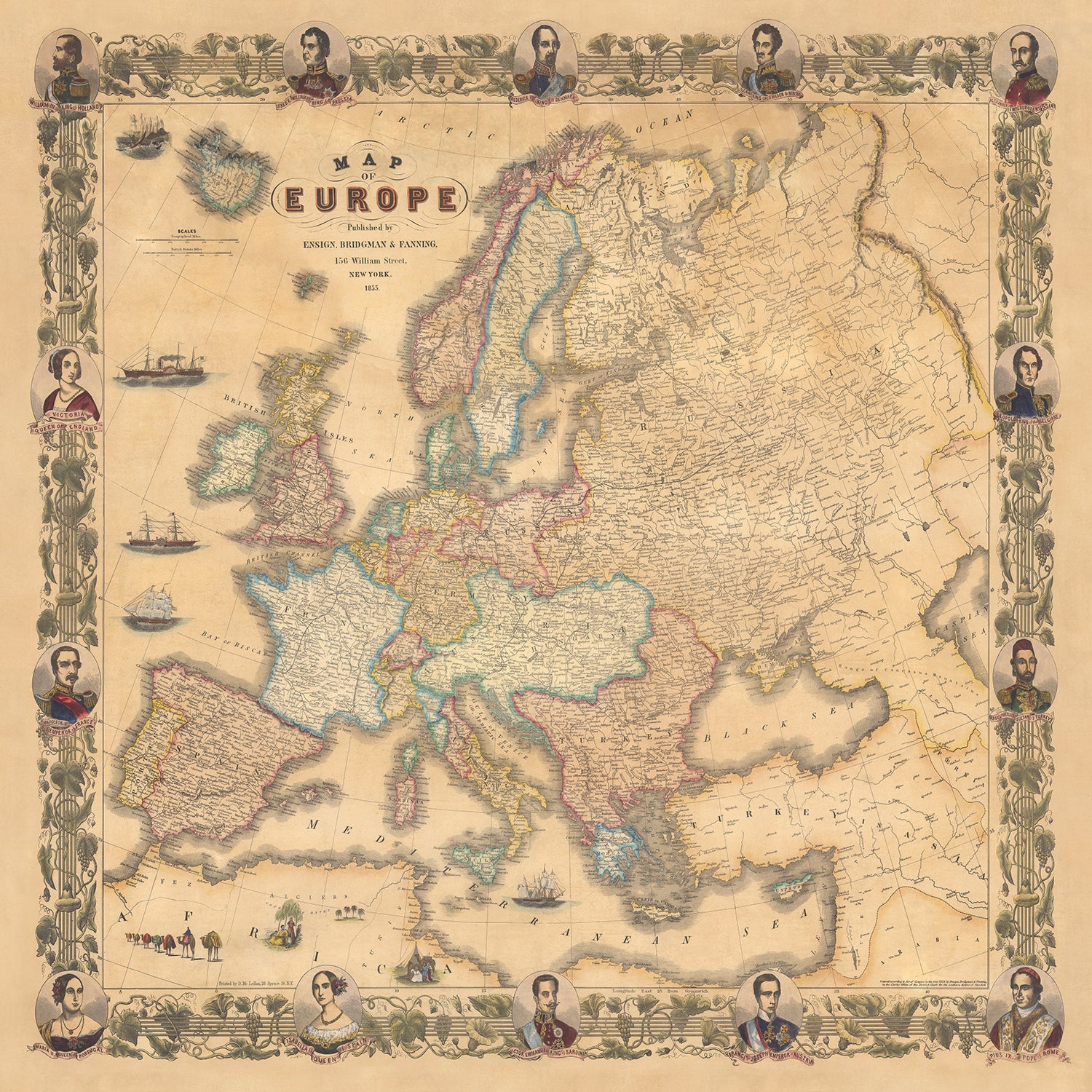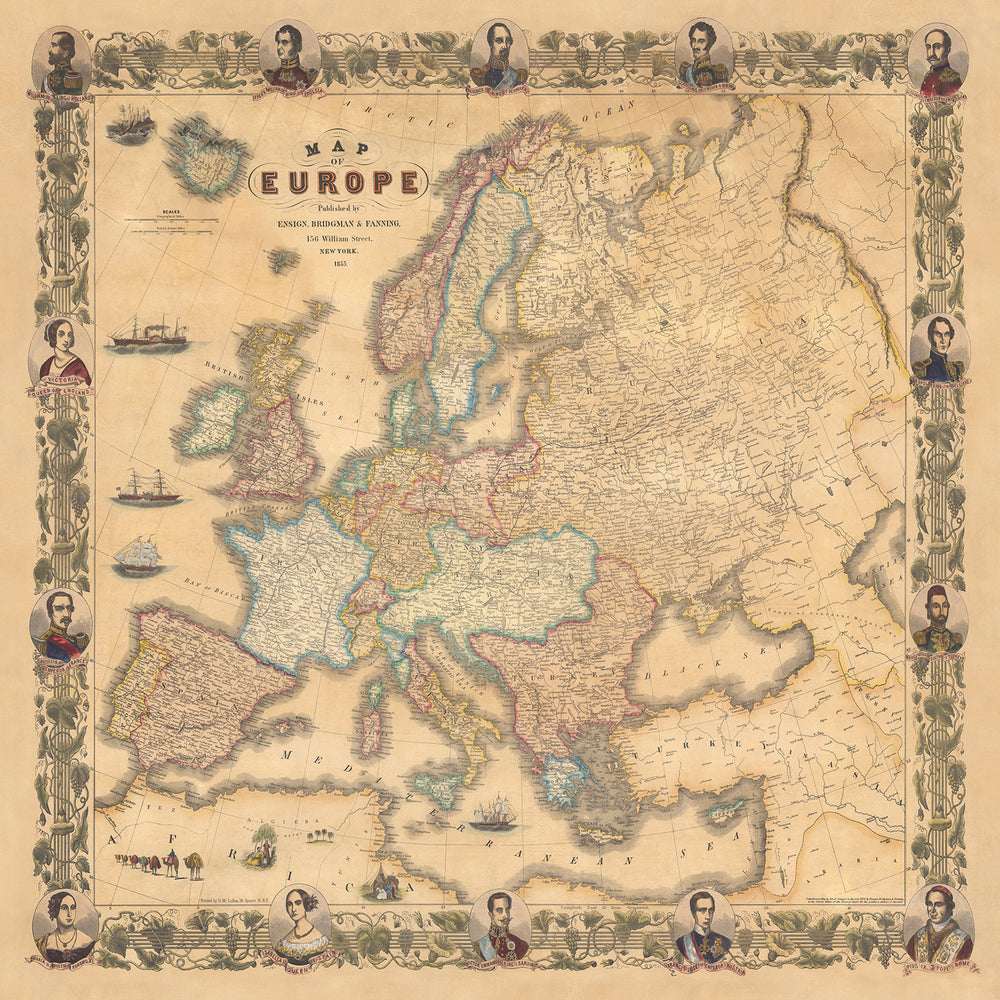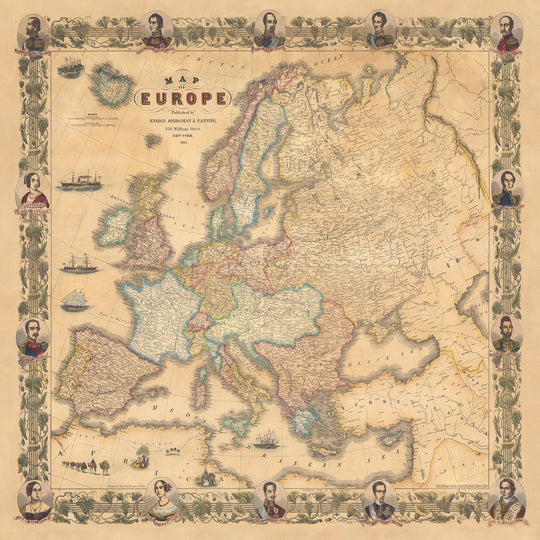- Handmade locally. No import duty or tax
- FREE Delivery by Christmas
- Love it or your money back (90 days)
- Questions? WhatsApp me any time
Own a piece of history
5,000+ 5 star reviews


The "Map of Europe," published by Ensign, Bridgman & Fanning in 1855, is a stunning example of mid-19th century cartography. This full-colour map beautifully captures the political and physical geography of continental Europe, extending all the way to the Ural Mountains in the east and encompassing Turkey and Syria. The map is framed by intricate portraits of prominent figures of the era, including Queen Isabella II of Spain, Napoleon III of France, Queen Victoria of England, and other notable rulers, reflecting the political landscape and monarchical power of the time.
If you have played any grand strategy video games like Europa Universalis, Crusader Kings, or Civilization, the feel of this map may strike a chord within you.
Created during a period of significant political change, this map not only serves as a geographical reference but also as a historical document. The detailed political boundaries and annotations provide insight into the complex and shifting alliances and territories of mid-19th century Europe. The inclusion of Turkey and Syria highlights the geopolitical importance of these regions, even in a map primarily focused on Europe. This map is a testament to the skill and artistry of Ensign, Bridgman & Fanning, who were renowned for their detailed and decorative maps.
The design of the map is both functional and decorative, featuring a rich, full-colour palette that enhances its visual appeal. The decorative border, adorned with floral and nautical motifs, adds an element of elegance, while the illustrations of ships and camel caravans evoke a sense of adventure and exploration. The map's cartographic projection is meticulously detailed, showcasing mountain ranges such as the Urals, Alps, Carpathians, and Pyrenees, as well as major bodies of water like the Atlantic Ocean, Mediterranean Sea, and Black Sea.
One of the most striking features of this map is the inclusion of portraits of contemporary leaders, which not only adds a decorative element but also provides historical context. The presence of these figures underscores the importance of monarchical and imperial power during this period, offering a glimpse into the political dynamics of the time. This combination of cartographic precision and artistic embellishment makes the map a unique and valuable piece for collectors and history enthusiasts alike.
In addition to its aesthetic and historical value, the map also serves as a fascinating study of mid-19th century cartographic techniques and styles. The careful attention to detail, from the depiction of sea routes to the annotations of major cities and regions, reflects the high standards of craftsmanship and accuracy that Ensign, Bridgman & Fanning were known for. This map is not just a representation of geographical knowledge but also a work of art that captures the spirit and complexity of its time.
Countries and regions on this map
- Countries:
- Spain
- Portugal
- France
- United Kingdom
- Ireland
- Belgium
- Netherlands
- Prussia (part of modern-day Germany)
- Denmark
- Sweden
- Norway
- Russia
- Austria
- Hungary
- Switzerland
- Italy
- Greece
- Turkey
- Syria
-
Various smaller states and regions that existed in mid-19th century Europe
-
Regions:
- Ural Mountains
- North Africa (depicted with camel caravans)
- Middle East (Turkey and Syria)
-
Various historical regions and states within Europe
-
Continents:
- Europe
- Parts of Asia (extending to the Ural Mountains)
- Parts of Africa (North Africa)
Notable Features & Landmarks
- Smaller inset maps or additional illustrations:
- Illustrations of ships in the Atlantic Ocean and Mediterranean Sea.
- Illustrations of camel caravans in North Africa.
- Bodies of water:
- Atlantic Ocean
- Mediterranean Sea
- Black Sea
- Baltic Sea
- Caspian Sea
- North Sea
- Adriatic Sea
- Mountain ranges:
- Ural Mountains
- Alps
- Carpathian Mountains
- Pyrenees
- Sea, road, and rail routes:
- Various sea routes depicted with ships.
- Other interesting features:
- Historical notes and annotations on various regions.
- Decorative elements with floral and nautical motifs.
- Labels for major cities and regions.
Historical and design context
- Historical significance or context:
- Created during a period of significant political change in Europe.
- Reflects the geopolitical landscape of mid-19th century Europe.
- The inclusion of portraits of rulers underscores the importance of monarchical and imperial power during this period.
- Design or style of the map:
- Full-colour, richly detailed.
- Decorative border featuring portraits of contemporary leaders.
- Nautical themes with illustrations of ships.
- Mapmaker or publisher:
- Ensign, Bridgman & Fanning, known for creating detailed and decorative maps during the mid-19th century.
- Published at 156 William Street, New York.
- Topics and themes shown on the map:
- Detailed political boundaries of Europe.
- Physical geography such as mountain ranges and bodies of water.
- The map includes portraits of notable rulers and figures of the time, indicating the political landscape of the era.
Please double check the images to make sure that a specific town or place is shown on this map. You can also get in touch and ask us to check the map for you.
This map looks great at every size, but I always recommend going for a larger size if you have space. That way you can easily make out all of the details.
This map looks amazing at sizes all the way up to 100in (250cm). If you are looking for a larger map, please get in touch.
Please note: the labels on this map are hard to read if you order a map that is 36in (90cm) or smaller. The map is still very attractive, but if you would like to read the map easily, please buy a larger size.
The model in the listing images is holding the 16x16in (40x40cm) version of this map.
The fifth listing image shows an example of my map personalisation service.
If you’re looking for something slightly different, check out my collection of the best old maps to see if something else catches your eye.
Please contact me to check if a certain location, landmark or feature is shown on this map.
This would make a wonderful birthday, Christmas, Father's Day, work leaving, anniversary or housewarming gift for someone from the areas covered by this map.
This map is available as a giclée print on acid free archival matte paper, or you can buy it framed. The frame is a nice, simple black frame that suits most aesthetics. Please get in touch if you'd like a different frame colour or material. My frames are glazed with super-clear museum-grade acrylic (perspex/acrylite), which is significantly less reflective than glass, safer, and will always arrive in perfect condition.
This map is also available as a float framed canvas, sometimes known as a shadow gap framed canvas or canvas floater. The map is printed on artist's cotton canvas and then stretched over a handmade box frame. We then "float" the canvas inside a wooden frame, which is available in a range of colours (black, dark brown, oak, antique gold and white). This is a wonderful way to present a map without glazing in front. See some examples of float framed canvas maps and explore the differences between my different finishes.
For something truly unique, this map is also available in "Unique 3D", our trademarked process that dramatically transforms the map so that it has a wonderful sense of depth. We combine the original map with detailed topography and elevation data, so that mountains and the terrain really "pop". For more info and examples of 3D maps, check my Unique 3D page.
For most orders, delivery time is about 3 working days. Personalised and customised products take longer, as I have to do the personalisation and send it to you for approval, which usually takes 1 or 2 days.
Please note that very large framed orders usually take longer to make and deliver.
If you need your order to arrive by a certain date, please contact me before you order so that we can find the best way of making sure you get your order in time.
I print and frame maps and artwork in 23 countries around the world. This means your order will be made locally, which cuts down on delivery time and ensures that it won't be damaged during delivery. You'll never pay customs or import duty, and we'll put less CO2 into the air.
All of my maps and art prints are well packaged and sent in a rugged tube if unframed, or surrounded by foam if framed.
I try to send out all orders within 1 or 2 days of receiving your order, though some products (like face masks, mugs and tote bags) can take longer to make.
If you select Express Delivery at checkout your order we will prioritise your order and send it out by 1-day courier (Fedex, DHL, UPS, Parcelforce).
Next Day delivery is also available in some countries (US, UK, Singapore, UAE) but please try to order early in the day so that we can get it sent out on time.
My standard frame is a gallery style black ash hardwood frame. It is simple and quite modern looking. My standard frame is around 20mm (0.8in) wide.
I use super-clear acrylic (perspex/acrylite) for the frame glass. It's lighter and safer than glass - and it looks better, as the reflectivity is lower.
Six standard frame colours are available for free (black, dark brown, dark grey, oak, white and antique gold). Custom framing and mounting/matting is available if you're looking for something else.
Most maps, art and illustrations are also available as a framed canvas. We use matte (not shiny) cotton canvas, stretch it over a sustainably sourced box wood frame, and then 'float' the piece within a wood frame. The end result is quite beautiful, and there's no glazing to get in the way.
All frames are provided "ready to hang", with either a string or brackets on the back. Very large frames will have heavy duty hanging plates and/or a mounting baton. If you have any questions, please get in touch.
See some examples of my framed maps and framed canvas maps.
Alternatively, I can also supply old maps and artwork on canvas, foam board, cotton rag and other materials.
If you want to frame your map or artwork yourself, please read my size guide first.
My maps are extremely high quality reproductions of original maps.
I source original, rare maps from libraries, auction houses and private collections around the world, restore them at my London workshop, and then use specialist giclée inks and printers to create beautiful maps that look even better than the original.
My maps are printed on acid-free archival matte (not glossy) paper that feels very high quality and almost like card. In technical terms the paper weight/thickness is 10mil/200gsm. It's perfect for framing.
I print with Epson ultrachrome giclée UV fade resistant pigment inks - some of the best inks you can find.
I can also make maps on canvas, cotton rag and other exotic materials.
Learn more about The Unique Maps Co.
Map personalisation
If you're looking for the perfect anniversary or housewarming gift, I can personalise your map to make it truly unique. For example, I can add a short message, or highlight an important location, or add your family's coat of arms.
The options are almost infinite. Please see my map personalisation page for some wonderful examples of what's possible.
To order a personalised map, select "personalise your map" before adding it to your basket.
Get in touch if you're looking for more complex customisations and personalisations.
Map ageing
I have been asked hundreds of times over the years by customers if they could buy a map that looks even older.
Well, now you can, by selecting Aged before you add a map to your basket.
All the product photos you see on this page show the map in its Original form. This is what the map looks like today.
If you select Aged, I will age your map by hand, using a special and unique process developed through years of studying old maps, talking to researchers to understand the chemistry of aging paper, and of course... lots of practice!
If you're unsure, stick to the Original colour of the map. If you want something a bit darker and older looking, go for Aged.
If you are not happy with your order for any reason, contact me and I'll get it fixed ASAP, free of charge. Please see my returns and refund policy for more information.
I am very confident you will like your restored map or art print. I have been doing this since 1984. I'm a 5-star Etsy seller. I have sold tens of thousands of maps and art prints and have over 5,000 real 5-star reviews. My work has been featured in interior design magazines, on the BBC, and on the walls of dozens of 5-star hotels.
I use a unique process to restore maps and artwork that is massively time consuming and labour intensive. Hunting down the original maps and illustrations can take months. I use state of the art and eye-wateringly expensive technology to scan and restore them. As a result, I guarantee my maps and art prints are a cut above the rest. I stand by my products and will always make sure you're 100% happy with what you receive.
Almost all of my maps and art prints look amazing at large sizes (200cm, 6.5ft+) and I can frame and deliver them to you as well, via special oversized courier. Contact me to discuss your specific needs.
Or try searching for something!















































